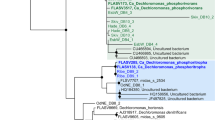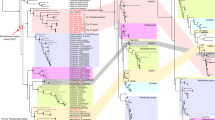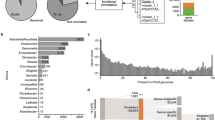Abstract
The glycogen-accumulating organism (GAO) ‘Candidatus Competibacter’ (Competibacter) uses aerobically stored glycogen to enable anaerobic carbon uptake, which is subsequently stored as polyhydroxyalkanoates (PHAs). This biphasic metabolism is key for the Competibacter to survive under the cyclic anaerobic-‘feast’: aerobic-‘famine’ regime of enhanced biological phosphorus removal (EBPR) wastewater treatment systems. As they do not contribute to phosphorus (P) removal, but compete for resources with the polyphosphate-accumulating organisms (PAO), thought responsible for P removal, their proliferation theoretically reduces the EBPR capacity. In this study, two complete genomes from Competibacter were obtained from laboratory-scale enrichment reactors through metagenomics. Phylogenetic analysis identified the two genomes, ‘Candidatus Competibacter denitrificans’ and ‘Candidatus Contendobacter odensis’, as being affiliated with Competibacter-lineage subgroups 1 and 5, respectively. Both have genes for glycogen and PHA cycling and for the metabolism of volatile fatty acids. Marked differences were found in their potential for the Embden–Meyerhof–Parnas and Entner–Doudoroff glycolytic pathways, as well as for denitrification, nitrogen fixation, fermentation, trehalose synthesis and utilisation of glucose and lactate. Genetic comparison of P metabolism pathways with sequenced PAOs revealed the absence of the Pit phosphate transporter in the Competibacter-lineage genomes—identifying a key metabolic difference with the PAO physiology. These genomes are the first from any GAO organism and provide new insights into the complex interaction and niche competition between PAOs and GAOs in EBPR systems.
Similar content being viewed by others
Log in or create a free account to read this content
Gain free access to this article, as well as selected content from this journal and more on nature.com
or
Accession codes
Accessions
GenBank/EMBL/DDBJ
References
Albertsen M, Hugenholtz P, Skarshewski A, Nielsen KL, Tyson GW, Nielsen PH . (2013). Genome sequences of rare, uncultured bacteria obtained by differential coverage binning of multiple metagenomes. Nat Biotechnol 31: 533–538.
Andreasen K, Nielsen PH . (2000). Growth of Microthrix parvicella in nutrient removal activated sludge plants: studies of in situ physiology. Water Res 34: 1559–1569.
Begum SA, Batista JR . (2012). Microbial selection on enhanced biological phosphorus removal systems fed exclusively with glucose. World J Microbiol Biotechnol 28: 2181–2193.
Belanger AE, Hatfull GF . (1999). Exponential-phase glycogen recycling is essential for growth of Mycobacterium smegmatis. J Bacteriol 181: 6670–6678.
Bengtsson S . (2009). The utilization of glycogen accumulating organisms for mixed culture production of polyhydroxyalkanoates. Biotechnol Bioeng 104: 698–708.
Bott M, Pfister K, Burda P, Kalbermatter O, Woehlke G, Dimroth P . (1997). Methylmalonyl-CoA decarboxylase from Propionigenium modestum—cloning and sequencing of the structural genes and purification of the enzyme complex. Eur J Biochem 250: 590–599.
Brown MR, Kornberg A . (2008). The long and short of it - polyphosphate, PPK and bacterial survival. Trends Biochem Sci 33: 284–290.
Burow L, Mabbett A, McEwan A, Bond P, Blackall L . (2008). Bioenergetic models for acetate and phosphate transport in bacteria important in enhanced biological phosphorus removal. Environ Microbiol 10: 87–98.
Burow LC, Kong Y, Nielsen JL, Blackall LL, Nielsen PH . (2007). Abundance and ecophysiology of Defluviicoccus spp., glycogen-accumulating organisms in full-scale wastewater treatment processes. Microbiology 153: 178–185.
Cecchini G, Schroder I, Gunsalus RP, Maklashina E . (2002). Succinate dehydrogenase and fumarate reductase from Escherichia coli. Biochim Biophys Acta 1553: 140–157.
Chandra G, Chater KF, Bornemann S . (2011). Unexpected and widespread connections between bacterial glycogen and trehalose metabolism. Microbiology 157: 1565–1572.
Clarridge III JE . (2004). Impact of 16S rRNA gene sequence analysis for identification of bacteria on clinical microbiology and infectious diseases. Clin Microbiol Rev 17: 840–862.
Conway T . (1992). The Entner-Douderoff pathway: history, physiology and molecular biology. FEMS Microbiol Rev 103: 1–28.
Crocetti GR, Banfield JF, Keller J, Bond PL, Blackall LL . (2002). Glycogen-accumulating organisms in laboratory-scale and full-scale wastewater treatment processes. Microbiology 148: 3353–3364.
Daims H, Stoecker K, Wagner M . (2005). Fluorescence in situ hybridization for the detection of prokaryotes. In: Molecular Microbial Ecology. Taylor & Francis: New York, NY, USA, pp 213–239.
Dupont CL, Rusch DB, Yooseph S, Lombardo MJ, Richter RA, Valas R et al (2012). Genomic insights to SAR86, an abundant and uncultivated marine bacterial lineage. ISME J 6: 1186–1199.
Elbein AD, Pan YT, Pastuszak I, Carroll D . (2003). New insights on trehalose: a multifunctional molecule. Glycobiology 13: 17R–27R.
Erb TJ, Berg IA, Brecht V, Muller M, Fuchs G, Alber BE . (2007). Synthesis of C5-dicarboxylic acids from C2-units involving crotonyl-CoA carboxylase/reductase: the ethylmalonyl-CoA pathway. Proc Natl Acad Sci U S A 104: 10631–10636.
Erb TJ, Fuchs G, Alber BE . (2009). (2S)-Methylsuccinyl-CoA dehydrogenase closes the ethylmalonyl-CoA pathway for acetyl-CoA assimilation. Mol Microbiol 73: 992–1008.
García-Martín H, Ivanova N, Kunin V, Warnecke F, Barry K, McHardy A et al (2006). Metagenomic analysis of two enhanced biological phosphorus removal (EBPR) sludge communities. Nature Biotechnol 24: 1263–1269.
He S, McMahon KD . (2011). Microbiology of ‘Candidatus Accumulibacter' in activated sludge. Microbial Biotechnol 4: 603–619.
He S, Kunin V, Haynes M, Martin HG, Ivanova N, Rohwer F et al (2010). Metatranscriptomic array analysis of 'Candidatus Accumulibacter phosphatis'-enriched enhanced biological phosphorus removal sludge. Environ Microbiol 12: 1205–1217.
He S, Gall DL, McMahon KD . (2007). "Candidatus Accumulibacter" population structure in enhanced biological phosphorus removal sludges as revealed by polyphosphate kinase genes. Appl Environ Microbiol 73: 5865–5874.
Huson DH, Mitra S, Ruscheweyh HJ, Weber N, Schuster SC . (2011). Integrative analysis of environmental sequences using MEGAN4. Genome Res 21: 1552–1560.
Jiang Y, Sorokin DY, Kleerebezem R, Muyzer G, van Loosdrecht M . (2011). Plasticicumulans acidivorans gen. nov., sp. nov., a polyhydroxyalkanoate-accumulating gammaproteobacterium from a sequencing-batch bioreactor. Int J Syst Evol Microbiol 61: 2314–2319.
Kalscheuer R, Steinbüchel A . (2003). A novel bifunctional wax ester synthase/acyl-CoA:diacylglycerol acyltransferase mediates wax ester and triacylglycerol biosynthesis in Acinetobacter calcoaceticus ADP1. J Biol Chem 278: 8075–8082.
Kawakoshi A, Nakazawa H, Fukada J, Sasagawa M, Katano Y, Nakamura S et al (2012). Deciphering the genome of polyphosphate accumulating actinobacterium Microlunatus phosphovorus. DNA Res 19: 383–394.
Kim JM, Lee HJ, Lee DS, Lee K, Jeon CO . (2011). Identification of a novel subgroup of uncultured gammaproteobacterial glycogen-accumulating organisms in enhanced biological phosphorus removal sludge. Microbiology 157: 2287–2296.
Kong Y, Xia Y, Nielsen JL, Nielsen PH . (2006). Ecophysiology of a group of uncultured gammaproteobacterial glycogen-accumulating organisms in full-scale enhanced biological phosphorus removal wastewater treatment plants. Environ Microbiol 8: 479–489.
Kong Y, Ong SL, Ng WJ, Liu W . (2002). Diversity and distribution of a deeply branched novel proteobacterial group found in anaerobic-aerobic activated sludge processes. Environ Microbiol 4: 753–757.
Konings WN, Otto R, Ten Brink B, Robillard GT, Elferink MG, Hellingwerf KJ . (1984). Relation between the protonmotive force and solute transport in bacteria. Biochem Soc Trans 12: 152–154.
Kornberg HL, Krebs HA . (1957). Synthesis of cell constituents from C2-units by a modified tricarboxylic acid cycle. Nature 179: 988–991.
Kornberg A, Rao NN, Ault-Riché D . (1999). Inorganic polyphosphate: a molecule of many functions. Annu Rev Biochem 68: 89–125.
Kristiansen R, Nguyen HTT, Saunders AM, Nielsen JL, Wimmer R, Le VQ et al (2013). A metabolic model for members of the genus Tetrasphaera involved in enhanced biological phosphorus removal. ISME J 7: 543–554.
Lemos P, Dai Y, Yuan Z, Keller J, Santos H, Reis M . (2007). Elucidation of metabolic pathways in glycogen-accumulating organisms with in vivo 13C nuclear magnetic resonance. Environ Microbiol 9: 2694–2706.
Lopez-Vazquez CM, Hooijmans CM, Brdjanovic D, Gijzen HJ, van Loosdrecht MC . (2009). Temperature effects on glycogen accumulating organisms. Water Res 43: 2852–2864.
Liu W-T, Mino T, Nakamura K, Matsuo T . (1994). Role of glycogen in acetate uptake and polyhydroxyalkanoate synthesis in anaerobic-aerobic activated sludge with a minimized polyphosphate content. J Ferm Bioeng 77: 535–540.
Lu H, Oehmen A, Virdis B, Keller J, Yuan Z . (2006). Obtaining highly enriched cultures of Candidatus Accumulibacter phosphatis through alternating carbon sources. Water Res 40: 3838–3848.
McIlroy SJ, Kristiansen R, Albertsen M, Karst SM, Rossetti S, Nielsen JL et al (2013). Metabolic model for the filamentous ‘Candidatus Microthrix parvicella' based on genomic and metagenomic analyses. ISME J 7: 1161–1172.
McIlroy S, Seviour RJ . (2009). Elucidating further phylogenetic diversity among the Defluviicoccus-related glycogen-accumulating organisms in activated sludge. Environ Microbiol Rep 1: 563–568.
Mielczarek AT, Nguyen HT, Nielsen JL, Nielsen PH . (2013). Population dynamics of bacteria involved in enhanced biological phosphorus removal in Danish wastewater treatment plants. Water Res 47: 1529–1544.
Mino T, Van Loosdrecht MCM, Heijnen JJ . (1998). Microbiology and biochemistry of the enhanced biological phosphate removal process. Water Res 32: 3193–3207.
Nguyen HT, Le VQ, Hansen AA, Nielsen JL, Nielsen PH . (2011). High diversity and abundance of putative polyphosphate-accumulating Tetrasphaera-related bacteria in activated sludge systems. FEMS Microbiol Ecol 76: 256–267.
Nielsen AT, Liu W, Filipe C, Grady L Jr, Molin S, Stahl DA . (1999). Identification of a novel group of bacteria in sludge from a deteriorated biological phosphorus removal reactor. Appl Environ Microbiol 65: 1251–1258.
Nielsen PH, Mielczarek AT, Kragelund C, Nielsen JL, Saunders AM, Kong Y et al (2010). A conceptual ecosystem model of microbial communities in enhanced biological phosphorus removal plants. Water Res 44: 5070–5088.
Oehmen A, Carvalho G, Lopez-Vazquez CM, van Loosdrecht MC, Reis MA . (2010). Incorporating microbial ecology into the metabolic modelling of polyphosphate accumulating organisms and glycogen accumulating organisms. Water Res 44: 4992–5004.
Oehmen A, Yuan Z, Blackall LL, Keller J . (2005). Comparison of acetate and propionate uptake by polyphosphate accumulating organisms and glycogen accumulating organisms. Biotechnol Bioeng 91: 162–168.
Oehmen A, Lemos PC, Carvalho G, Yuan Z, Keller J, Blackall LL et al (2007). Advances in enhanced biological phosphorus removal: from micro to macro scale. Water Res 41: 2271–2300.
Oehmen A, Yuan Z, Blackall LL, Keller J . (2004). Short-term effects of carbon source on the competition of polyphosphate accumulating organisms and glycogen accumulating organisms. Water Sci Technol 50: (10): 139–144.
Oksanen et al (2011), Vegan: community ecology package. R package version 2.0-5.
Ostle A, Holt J . (1982). Nile blue A as a fluorescent stain for poly-beta-hydroxybutyrate. Appl Environ Microbiol 44: 238–241.
Portais JC, Delort AM . (2002). Carbohydrate cycling in micro-organisms: what can (13)C-NMR tell us? FEMS Microbiol Rev 26: 375–402.
Preiss J . (2006). Bacterial glycogen inclusions: enzymology and regulation of synthesis. In: Microbiology Monographs. Shively JM (ed). Springer-Verlag: Berlin, pp 71–108.
Rehm BH . (2003). Polyester synthases: natural catalysts for plastics. Biochem J 376: 15–33.
Rho M, Tang H, Ye Y . (2010). FragGeneScan: predicting genes in short and error-prone reads. Nucleic Acids Res 38: e191.
Richter M, Rosselló-Móra R . (2009). Shifting the genomic gold standard for the prokaryotic species definition. Proc Natl Acad Sci USA 106: 19126–19131.
Saunders A, Mabbett A, McEwan A, Blackall L . (2007). Proton motive force generation from stored polymers for the uptake of acetate under anaerobic conditions. FEMS Microbiol Lett 274: 245–251.
Schroeder S, Petrovski S, Campbell B, McIlroy S, Seviour RJ . (2009). Phylogeny and in situ identification of a novel gammaproteobacterium in activated sludge. FEMS Microbiol Lett 297: 157–163.
Seviour RJ, McIlroy S . (2008). The microbiology of phosphorus removal in activated sludge processes- the current state of play. J Microbiol 46: 115–124.
Seviour RJ, Mino T, Onuki M . (2003). The microbiology of biological phosphorus removal in activated sludge systems. FEMS Microbiol Rev 27: 99–127.
Seviour T, Lambert LK, Pijuan M, Yuan Z . (2010). Structural determination of a key exopolysaccharide in mixed culture aerobic sludge granules using NMR spectroscopy. Environ Sci Technol 44: 8964–8970.
Seviour TW, Lambert LK, Pijuan M, Yuan Z . (2011). Selectively inducing the synthesis of a key structural exopolysaccharide in aerobic granules by enriching for Candidatus "Competibacter phosphatis". Appl Microbiol Biotechnol 92: 1297–1305.
Smolders GJF, van der Meij J, van Loosdrecht MCM, Heijnen JJ . (1994). Stoichiometric model of the aerobic metabolism of the biological phosphorus removal process. Biotechnol Bioeng 44: 837–848.
Vallenet D, Engelen S, Mornico D, Cruveiller S, Fleury L, Lajus A et al (2009). MicroScope: a platform for microbial genome annotation and comparative genomics. Database (Oxford) 2009: bap021.
Vallenet D, Labarre L, Rouy Z, Barbe V, Bocs S, Cruveiller S et al (2006). MaGe: a microbial genome annotation system supported by synteny results. Nucleic Acids Res 34: 53–65.
van Veen HW, Abee T, Kortstee GJ, Pereira H, Konings WN, Zehnder AJ . (1994). Generation of a proton motive force by the excretion of metal-phosphate in the polyphosphate-accumulating Acinetobacter johnsonii strain 210A. J Biol Chem 269: 29509–29514.
Wang X, Zeng RJ, Dai Y, Peng Y, Yuan Z . (2008). The denitrification capability of cluster 1 Defluviicoccus vanus-related glycogen-accumulating organisms. Biotechnol Bioeng 99: 1329–1336.
Wexler M, Richardson DJ, Bond PL . (2009). Radiolabelled proteomics to determine differential functioning of Accumulibacter during the anaerobic and aerobic phases of a bioreactor operating for enhanced biological phosphorus removal. Environ Microbiol 11: 3029–3044.
Wilmes P, Andersson AF, Lefsrud MG, Wexler M, Shah M, Zhang B et al (2008). Community proteogenomics highlights microbial strain-variant protein expression within activated sludge performing enhanced biological phosphorus removal. ISME J 2: 853–864.
Wolf A, Kramer R, Morbach S . (2003). Three pathways for trehalose metabolism in Corynebacterium glutamicum ATCC13032 and their significance in response to osmotic stress. Mol Microbiol 49: 1119–1134.
Wong M, Liu W . (2007). Ecophysiology of Defluviicoccus-related tetrad-forming organisms in an anaerobic-aerobic activated sludge process. Environ Microbiol 9: 1485–1496.
Wong M, Liu W . (2006). Microbial succession of glycogen accumulating organisms in an anaerobic-aerobic membrane bioreactor with no phosphorus removal. Water Sci Technol 54: (1): 29–37.
Wong M, Tan FM, Ng WJ, Liu W . (2004). Identification and occurrence of tetrad-forming Alphaproteobacteria in anaerobic-aerobic activated sludge processes. Microbiology 150: 3741–3748.
Wrighton KC, Thomas BC, Sharon I, Miller CS, Castelle CJ, VerBerkmoes NC et al (2012). Fermentation, hydrogen, and sulfur metabolism in multiple uncultivated bacterial phyla. Science 337: 1661–1665.
Zeng RJ, Yuan Z, Keller J . (2003). Enrichment of denitrifying glycogen-accumulating organisms in anaerobic/anoxic activated sludge system. Biotechnol Bioeng 81: 397–404.
Zengin GE, Artan N, Orhon D, Chua AS, Satoh H, Mino T . (2010). Population dynamics in a sequencing batch reactor fed with glucose and operated for enhanced biological phosphorus removal. Bioresource Technol 101: 4000–4005.
Acknowledgements
The study was funded by Aalborg University, Krüger AS and the Danish Council for Strategic Research (EcoDesign-MBR). We thank JL Nielsen and M Stevenson for the MAR-FISH analysis. We also acknowledge the LABGeM team at Genoscope for providing access to their automated annotation pipeline as well as for database maintenance and technical assistance.
Author information
Authors and Affiliations
Corresponding author
Ethics declarations
Competing interests
The authors declare no conflict of interest.
Additional information
Supplementary Information accompanies this paper on The ISME Journal website
Supplementary information
Rights and permissions
About this article
Cite this article
McIlroy, S., Albertsen, M., Andresen, E. et al. ‘Candidatus Competibacter’-lineage genomes retrieved from metagenomes reveal functional metabolic diversity. ISME J 8, 613–624 (2014). https://doi.org/10.1038/ismej.2013.162
Received:
Revised:
Accepted:
Published:
Issue date:
DOI: https://doi.org/10.1038/ismej.2013.162
Keywords
This article is cited by
-
Effect of Magnetic Field Enrichment Conditions on the Synthesis of Polyhydroxyalkanoates by Activated Sludge
Waste and Biomass Valorization (2024)
-
Biological and Chemical Approaches for Controlling Harmful Microcystis Blooms
Journal of Microbiology (2024)
-
Ethylmalonyl-CoA pathway involved in polyhydroxyvalerate synthesis in Candidatus Contendobacter
AMB Express (2022)
-
Microbial composition and nitrogen removal pathways in a novel sequencing batch reactor integrated with semi-fixed biofilm carrier: evidence from a pilot study for low- and high-strength sewage treatment
Environmental Science and Pollution Research (2022)
-
Effects of the aeration mode on nitrogen removal in a compact constructed rapid infiltration system for advanced wastewater treatment
Environmental Science and Pollution Research (2022)



